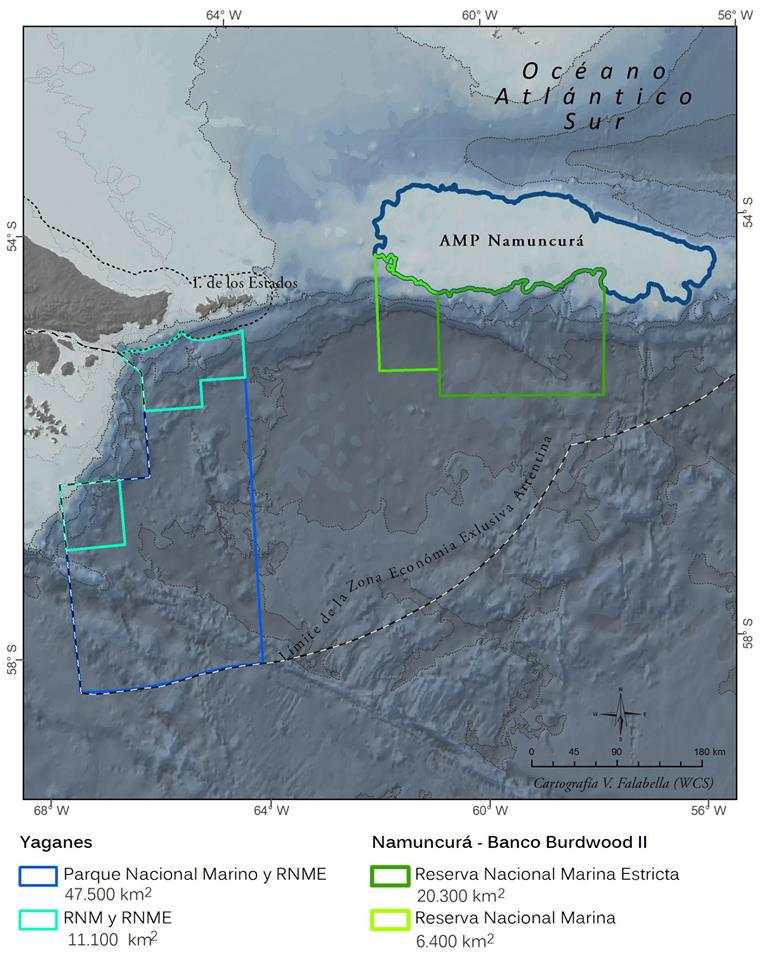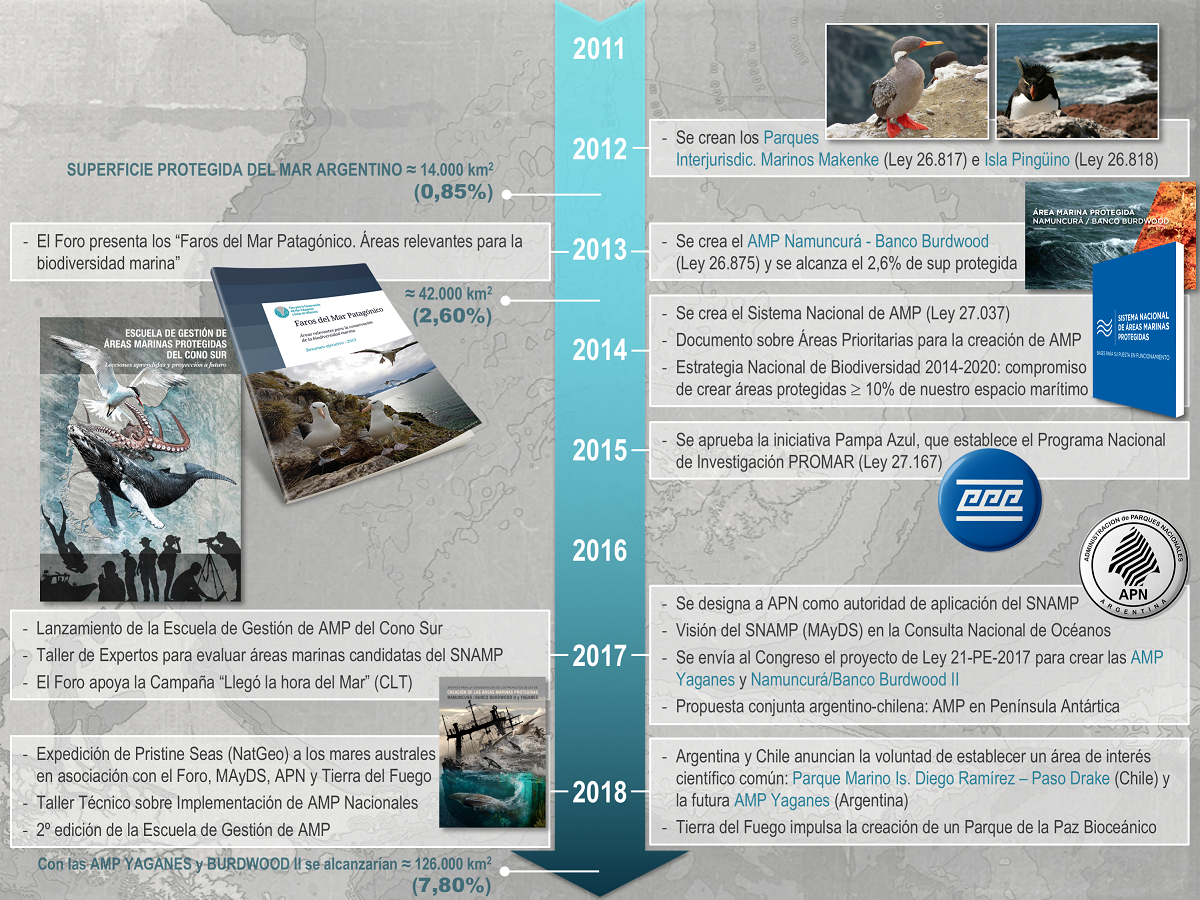NGM maps
source : Administracio de Parques Nacionales de Argentina
From National Geographic by Sarah Gibbens
Argentina's government has voted to create two new marine parks that cover an area the size of Hungary.
TWO NEW MARINE parks that together make up an area the size of Hungary have been created in the South Atlantic Ocean.
One is called Yaganes and is located just off the southern tip of Argentina—a spot nicknamed “the end of the world.”
The other, Namuncurá-Burdwood Bank II, is in the South Atlantic. Together, they make up 37,000 square miles of marine protected areas (MPAs) teeming with sea creatures, many of which are classified as threatened species.
source Mar Patagonico
Portions of these new MPAs have remained pristine by default of their remoteness, and the Argentine government’s decision to protect them ensures that the marine ecosystems will stay that way. Conservationists are hoping this move signals a shift toward stronger conservation measures in the country.
Not only because the decision designates more protected territory, but also because it comes with a legal framework to enforce the new restrictions.
“It's much more than creating two national parks,” says Sofia Heinonen, president of Fundación Flora y Fauna Argentina, an environmental group that led a campaign in favor of the new marine parks. “This also creates the basis for the next one.”
Sea conservation timeline for Argentina
Why is this part of the sea so special?
Previously, Argentina's marine parks were managed by the same government department that manages its fisheries, which are open to commercial interests.
This left little funding to stop illegal activity in the parks that could undermine bans on extractive activities like fishing there.
An earlier Argentine MPA called Namuncurá-Burdwood Bank I, created in 2013, had weak oversight.
A legal framework to manage the park wasn’t passed until 2015, and Argentina’s National Parks Administration didn’t gain control until 2017.
At the same time, according to local media outlets, fishing pressure has increased immediately south of Argentina in recent years.
So in an attempt to protect Argentina’s waters, the National Geographic Society partnered with the Forum for the Conservation of the Patagonian Sea and local governments to survey the region.
The goal was to assess the health of the marine ecosystems known for their impressive biodiversity.
“We wrote very comprehensive scientific reports that supported the immense ecological value of this area and the need for protection,” says Alex Muñoz, the leader of the Latin American arm of National Geographic's Pristine Seas program.
And earlier this year, Fundación Flora y Fauna Argentina and the National Geographic Society received part of a record $1 billion donation made by the conservation-focused Wyss Foundation to groups working to create natural reserves like marine protected areas and national parks.
Yaganes y Burdwood2 new MPAs
During National Geographic’s recent exploration of Yaganes and Namuncurá-Burdwood Bank, researchers and photographers maneuvered cameras more than 6,000 feet below the surface.
They found underwater mountain ranges and deep-sea canyons home to an impressive array of diversity. Many of the species identified can only be found in this part of the world.
So, too, with marine mammals. Yaganes was once a lucrative spot for hunting whales—an activity that severely impacted southern right whale populations.
But since this hunting activity ended in Argentina after the country joined the International Whaling Commission in 1960, populations have slowly begun to rebound.
Reaching an ocean conservation goal
With the creation of these two new marine protected areas, 8 percent of Argentina’s waters are now protected, bringing the country closer to its goal of protecting 10 percent of its national waters by 2020.
MPAs are a popular tool used by governments to meet the United Nations’ larger goal of protecting 10 percent of the world’s oceans by 2020.
By closing regions to activities like fishing, MPAs can allow fish stocks to recover, which then spill out to commercial areas.
In a previous interview with National Geographic, former NOAA administrator Jane Lubchenco likened MPAs to a shot of vitamin C before the onset of a cold.
A March study, partially supported by Pristine Seas, found that many declared protected areas around the globe are not effectively enforced.
And even with countries’ self-reported conservation declarations, the U.N. is predicted to fall short of it goal.
But countries like Argentina aren’t giving up.
“Argentina is catching up on marine conservation,” Muñoz says.
“Now it's becoming a world leader in world conservation.”
Heinonen says her organization’s future conservation work will involve talks with Chile, a country that also shares close proximity to Antarctica.
They hope to create joint protected areas in the South Atlantic Ocean.
Links :
- Global Fishing watch : Watch data key to MPA victory in Argentina
- Sinazulnohayverde
- GeoGarage blog : Bigger is not better for ocean conservation / The race for vast remote 'marine protected areas ... / Diving live in the Endeavour MPA in Canada / Explore Marine Protected Areas / Future of Antarctic marine protected areas is at risk




Marine Protected Areas
ReplyDelete